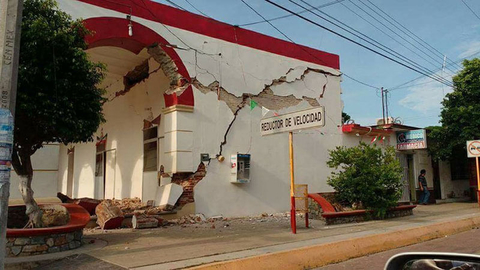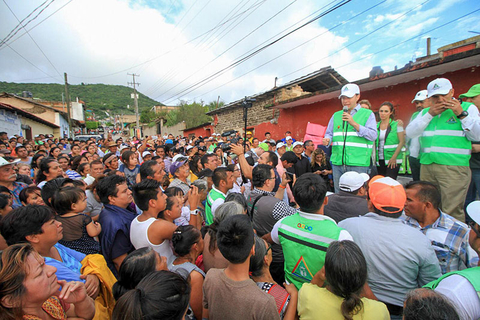As natural disasters preoccupy our attention in the U.S., Mexico is struggling through an ordeal of its own.
The strongest earthquake in a century struck off the country’s southwestern coast on September 7. As of press time, the quake is responsible for taking nearly 100 lives in the southern states of Oaxaca, Chiapas and Tabasco. It was felt as far away as Mexico City, more than 600 miles away.
The tremblor measured 8.1 on the Richter Scale, according to the US Geological Survey. Mexican official readings pegged it at 8.2. And the Mexican Seismological Service reported close to 1,000 aftershocks.
Following the quake, officials issued tsunami warnings and briefly evacuated parts of coastal Tonalá and Puerto Madera; but no damage was reported from the sea, at least due to the earthquake. (The country’s eastern coast was hit by Hurricane Katia at roughly the same time.)
The region of Mexico closest to the quake is known as the Isthmus of Tehuantepéc. It’s a narrow stretch of land that connects Mexico to Guatemala. Surf aficionados have long eyed its potential, as have adventure, eco-tourism and culture-oriented tour operators. Chiapas is Mexico’s poorest state and certainly could use the help.
The more well-known tourist destinations within the range of the quake are operational. In addition to Mexico City, that includes Puebla, Puerto Vallarta, Huatulco and Acapulco.

A damaged building in Oaxaca
“As it relates to suppliers, I haven’t heard about any issues,” John Diorio, The Mark Travel Corporation regional director of sales for the West/Mountain region tells Travel Agent.
To say that Mexico is prone to earthquakes is an understatement. It sits above five tectonic plates. The capital also lies atop a former lakebed, which serves to magnify seismic activity.
Last Thursday’s earthquake was stronger than the 1985 quake that killed 10,000 people and flattened much of Mexico City. It was farther away this time, but still rattled things up. Buildings swayed, and a video of a shaking Angel of Independence monument went viral. Thanks to an early warning system implemented after the 1985 quake, people had a minute to take cover. Other than a brief loss of power, Mexico City rode the quake out with only minor structural damage and no serious injuries.
Some 60 miles from Mexico City in Puebla, the earthquake made an impact, according to Federico Spada, general manager at La Purificadora Hotel. The Grupo Habita property occupies an historic 19th century former factory building.
“The earthquake was really strong. It lasted more than three minutes. I had an event on the roof top bar. The pool had waves as if for surfing. But, all went well and our security did a great job. None of our guests left earlier than expected. Everyone was impressed that an historical building could hold up so well,” Spada tells Travel Agent.
Towns closer to the epicenter fared much worse.
Oaxaca State bore the brunt of the fatalities. The majority were in Juchitán de Zaragoza. More than 5,000 homes were destroyed. Municipal buildings, schools and churches were reduced to rubble. At least 36 died, with more than 300 injured.
Fifteen people died in neighboring Chiapas, with four additional victims in Tabasco.
Mexico’s president Enrique Peña Nieto visited Juchitán’s devastated downtown after the quake. Other officials, such as Chiapas governor Manuel Velasco Coello, took to Facebook Live to broadcast tours of damaged sites.

Chiapas Govorner Manuel Velasco Coello speaks to a crowd
Up the Pacific coast in Oaxaca State, the tourist destination of Huatulco weathered the quake.
According to the Secretariat of Tourism (SECTUR) for Oaxaca, the destinations of Huatulco, Puerto Escondido and Oaxaca de Juarez reported no damage.
“In Huatulco, all is perfect. The airport works without problem,” a spokesperson for Huatulco tells Travel Agent.
A social media posting from SECTUR Chiapas over the weekend read:
“We’ve monitored the infrastructure of our main destinations, including Tuxla Gutierrez, San Cristobal, Comitán, Palenque, and Tapachula. They report no damage that will make them unable to serve guests. Chiapas is 100 percent in tourist services, to receive them warmly.”
An additional posting emphasized that hotels were in “optimal condition,” and added, “tourism makes us stronger.”
Farther up the coast, authorities in Acapulco reported:
“All tourism infrastructure, including the airport, is fully operational after the 8.2 earthquake that struck the Mexican Pacific coast last night. After the quake, a tsunami warning was issued and later withdrawn, as city is now safe from hazardous waves.”
Continuing up the coast, some people in Puerto Vallarta reported feeling the tremor, but there were no reports of damage or injury.
The Pacific’s Costalegre lies between Puerto Vallarta and Manzanillo on the Jalisco Coast. Wayne Hudson, spokesperson for the private Las Rosadas resort, reported all is well.
“Luckily, no problems in the Careyes (private resort) area. I guess they are just far enough north,” Hudson tells Travel Agent.
As with other natural disasters, social media proved valuable in relaying updates, images and personal stories.
Fellow states also suggested lending a hand on the tourist front. One example, this posting from Yucatan:
“Visit them when they need you most. Remember there are direct flights from Merida to Tuxla Gutierrez.”
Related Stories
Katia Downgraded to a Tropical Depression; Weakens as it Hits Mexico
The Latest Irma Cruise Cancellations and Updates
Acapulco Reports Airport Operational After Earthquake
Biggest Earthquake in a Century Strikes Mexico; Hurricane Near